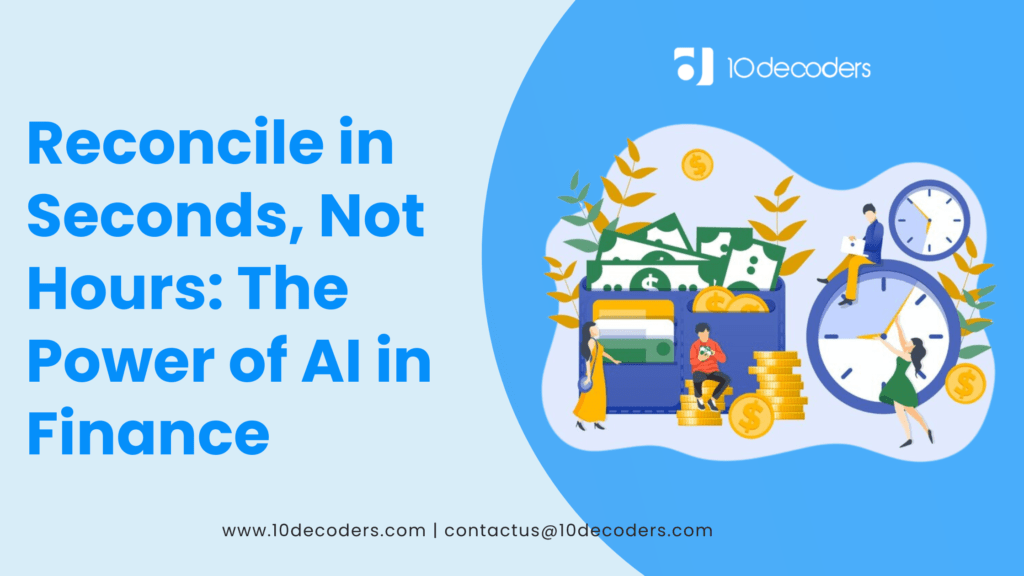Reconcile in Seconds, Not Hours: The Power of AI in Finance
Introduction
Finance departments have long been burdened with slow-moving, manual processes, and reconciliation is perhaps the most time-consuming of them all. Until recently, this critical function was a tedious and labor-intensive task, consuming valuable resources and time. With the rise of automation and artificial intelligence (AI), financial reconciliation is undergoing a complete transformation.
All About the Traditional Financial Reconciliation Process
Every business, regardless of size, must ensure that its internal financial records align with bank statements. This requires manually matching invoices, receipts, and payment records, a process that can be overwhelming for large organizations. Finance teams spend hours meticulously reviewing transactions, cross-checking numbers, and verifying financial data. It’s a necessary but grueling task, often prone to human error and inefficiencies.
Current Challenges with Manual Financial Reconciliation
For finance professionals, the struggles of manual financial reconciliation are all too familiar. Here are some of the key challenges:
- Difficulty in Finding the Right Data
Locating specific transactions amidst a sea of financial records can feel like searching for a needle in a haystack. No matter how diligently teams sift through documents, pinpointing the exact data remains a challenge.
- Vulnerability to Errors
Humans, despite their best efforts, are prone to mistakes. Even a minor error in matching transactions can lead to discrepancies that take additional time to resolve, causing delays in financial reporting and reconciliation.
- Scalability Issues
As a business grows, so does the volume of financial transactions. Manual account reconciliation, which might be feasible for a small company, quickly becomes unmanageable for larger enterprises. The increasing workload often leads to bottlenecks and inefficiencies.
- Sluggish Financial Reporting
Manually preparing financial reports can be a slow and frustrating process. With teams spending significant time on reconciliation, businesses face delays in generating accurate and timely reports, which can impact decision-making and overall financial management.
Why Financial Reconciliation Automation is the Future
AI-driven automation—an advanced solution that eliminates the inefficiencies of manual reconciliation. With AI, businesses no longer have to spend countless hours searching through financial records. Instead, AI-powered systems can process and reconcile transactions in seconds. The benefits of financial reconciliation automation are:
- Speed and Efficiency – AI processes thousands of transactions in seconds, reducing the time spent on reconciliation from hours to mere moments.
- Higher Accuracy – AI eliminates human errors, ensuring financial records are precise and reliable.
- Cost Savings – Automation reduces the need for extensive manpower, allowing finance teams to focus on high-value tasks.
- Improved Reporting – Faster and error-free reconciliation leads to more timely and insightful financial reports.
- Scalability – AI-powered systems effortlessly handle increasing transaction volumes, ensuring smooth reconciliation as businesses expand.
Learn How Financial Reconciliation Automation Works
Conventional financial reconciliation requires extensive coding, numerous manual steps, and multiple personnel to verify financial data. The modern AI-driven approach, however, streamlines the process by utilizing an intelligent tool that works with simple data inputs and policy prompts. Instead of manually comparing transactions, finance teams now simply input the required data and set a policy prompt. The AI system then:
- Scans and Analyzes – AI sifts through large volumes of transactions, identifying matches and discrepancies in real-time.
- Detects Errors and Flags Issues – Automated discrepancy detection ensures that any anomalies or mismatches are immediately highlighted for review.
- Learns and Adapts – The AI system continuously improves by recognizing business-specific transaction patterns, leading to even more accurate reconciliation over time.
- Generates Reports – AI compiles financial data into clear, accurate reports, providing real-time insights that aid in decision-making.
One of the key advantages of AI-driven bank reconciliation is that businesses remain in control. Finance professionals set the initial parameters, allowing AI to handle the complex work while ensuring that any discrepancies requiring human judgment are flagged for review. This balance between automation and human oversight guarantees that nothing is overlooked while maximizing efficiency.
By automating financial reconciliation, businesses can finally eliminate the stress associated with manual processes. The shift from manual to automated reconciliation translates to:
- Minimal Errors – AI ensures precision and consistency, reducing costly financial discrepancies.
- Time Savings – Automated reconciliation frees up finance teams to focus on strategic initiatives rather than repetitive tasks.
- Greater Efficiency – AI accelerates workflows, enabling businesses to operate more smoothly and make data-driven financial decisions.
- Enhanced Compliance – Accurate and timely reconciliation ensures adherence to financial regulations and reporting standards.
The Future of Finance: AI-Driven Optimization
Financial reconciliation automation is not just an upgrade—it’s a game-changer. By harnessing AI-powered solutions, finance teams can revolutionize their operations, transforming a traditionally cumbersome process into an effortless and accurate system. With AI handling the heavy lifting, businesses can redirect their focus towards innovation, growth, and strategic financial management.
Key Takeaway
Balance sheet reconciliation, once a tedious and error-prone process, is now being transformed by AI-driven automation. This revolution not only saves time and money but also enhances accuracy and efficiency. As businesses continue to embrace digital transformation, automated financial reconciliation will become the new standard, allowing finance teams to focus on what truly matters—strategic growth and financial excellence. The future of finance is here, and it’s powered by AI.



